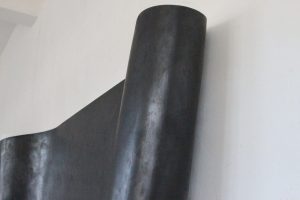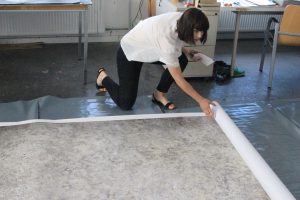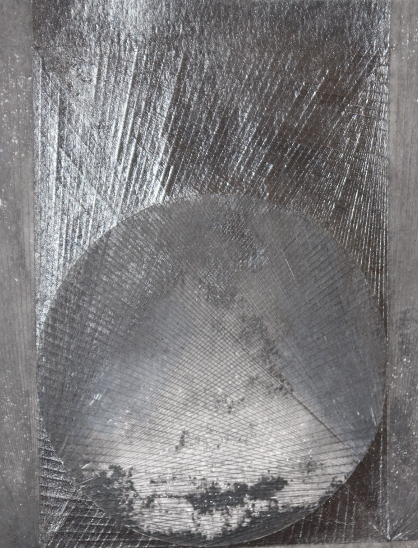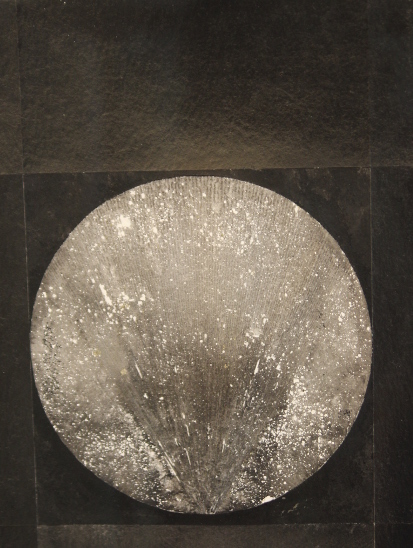Wanda Stolle
– dark colors with a coal-like shimmer, applied layer upon layer, the surface tooled and landscaped. Large, space-filling canvasses, but also small-scale pieces, which the artist engraves with fine patterns made up of carefully drawn black lines, seemingly three-dimensional, folded, the result: graphite, vibrant and expressive. Wanda Stolle creates darkly glistening, monochrome pieces that make room for the viewer’s imagination.
PORTRAIT - WANDA STOLLE > read more

Wanda Stolle – flogra
A wooden wall sculpture, nearly 2 meters wide and 1.20 meters high, made of bentwood: “Flogra”—an old Nordic word for flag—by Wanda Stolle, a young artist from Berlin. The ends of the sculpture bulge out into the room, the edges rolling in toward the wall like parchment or a banner in the wind. Many hues of gray, traces of scraping, smudging; light and lustrous. The surface of the sculpture shimmers in tones of gray—and perhaps a little blue…? “No, that’s just a reflection of the sky,” says the artist and explains that in the evening it absorbs the colors of the sunset and takes on a reddish glow: The sculpture communicates with the light and space around it and intensifies the effect of its surroundings. For weeks on end, the artist shades and smudges, creating shimmering graphite surfaces that take on a life of their own.
Wanda Stolle’s drawings and paintings look like sculptures, but for her, “they’re sculpted paintings, because I need a wall to relate to; on the other hand, I work on my sculptures as if they were drawings.” Which leads the young Berlin artist directly to the question: “What is a painting?”
Wanda Stolle was born in Berlin in 1985 and grew up in the city’s Pankow district. She has always drawn, and today she still draws to give shape to things that words cannot express.
After graduating from high school, she left Germany and went to Brazil. In this entirely different world—while experiencing a totally new culture, a very different way of living, learning a new language, exploring landscapes, and getting to know the country and its people—she began to use a pencil to record the things that were most important to her in this new and exciting environment. She drew, made notes and worked. What was essential, what were the decisive structures?
She returned with a more observant eye. Today, when she points at the view from her studio in Berlin, she sees “the face of the house over there, in relation to the sky and the almost ornamental nature of the bricks—their color, texture and layout. For me that’s essential.” Portraits of people? “They have a narrative quality I want to exclude.”
Wanda Stolle applied to Berlin University of the Arts (UdK) with the drawings she had produced while in Brazil. She was accepted and majored in two fields: teaching and fine arts. Her professors included Frank Badur and Pia Fries. She graduated in 2012 and 2013 and received one of the coveted scholarships awarded each year to the three best graduates.
In the first years of her studies, her focus was on “the force of color,” especially in silicone, until she realized that this was just a period of wild exploration: “That wasn’t what I was really interested in! I recognized that I wanted to delve deeper, working within the confines of a limited and austere palette.”
She revels in endless shades of grey, enjoys pouring ink over her works. Seeing and understanding: light is an elemental part of her paintings. Many of her black and grey paintings reflect light and develop a life of their own: “That brings out color!” Other paintings by the artist appear to be dull and without shine, but they absorb light—drawing us into their depths, forcing us to perceive ourselves.
My work is distinguished by a certain kind of sensuality,” Wanda Stolle explains. “The darkness of the colors, almost meditative… and the physicality viewers experience—if they move!” What she demands of her viewers—and at the same time compellingly conveys—is a change of perspective.
While still at university, she produced a large painting in which she played with perspectives and viewers: when approached by viewers, its reflection seemed to show them retreating. In another large wall sculpture, its two ends bulged out into the room: the viewer was reflected–life-size, but completely distorted. Only at the center line of the piece was there a spot that reflected the person without distortion, a technique referred to as anamorphosis, which systematically makes use of reflection. “You can only see it if you move,” the artist explains. Light and reflection—or the complete lack of reflection—as fundamental elements of her work; space and the movements of viewers as part of her sculptures.
A heavy folder contains Wanda Stolle’s treasures: hundreds of photographs from books on astronomy, art history and science, usually discovered in antiquarian books. Image details, photographs, art; images that immediately appealed to her and touched her in some way. For example, a picture from a 1930s’ mountaineering magazine. The only thing in the photograph is a rope, hanging next to a rock wall against an open sky. Stolle proceeds to place a photograph of a madonna next to it, a piece created by an unknown 16th century master. A crack runs through the wooden beauty of the madonna’s face. “Deep like a wound, a clear line”—and she shows that it is exactly the same line so clearly drawn by that the rope next to the rock wall. “That works together,” she comments, inspired to create images, sometimes series, of corresponding lines, structures…
Stolle used a box cutter for the first time while still at university. She used this cutting tool and the equally sharp lines it draws to work on series, which also included small-scale pieces. She cut them—wounded them so to speak—gently poured ink over the pieces, let it flow and then smudged them. Making use of chance, but also exerting control. The fine lines cut into these delicate pieces cause them to virtually ´spring up`, they bulge out into the room. We experience new perspectives of paintings that were actually meant to be flat for a wall—the more we move around the piece, the more perspectives we discover.
Wanda Stolle elegantly forces her viewers to become aware of what is essential—and of how many different perspectives exist.
 Wanda Stolle’s work has already been shown several times in Berlin, including at exhibitions in the Arndt and Reiter galleries, as well as in Leipzig and Landshut.
Wanda Stolle’s work has already been shown several times in Berlin, including at exhibitions in the Arndt and Reiter galleries, as well as in Leipzig and Landshut.
She will be taking part in a group exhibition at the Goethe Institute in Rouen, France in 2018, and next spring, the Reiter Gallery in Berlin will hold a solo exhibition of her work.
© Heike Rudloff Berlin 2017




